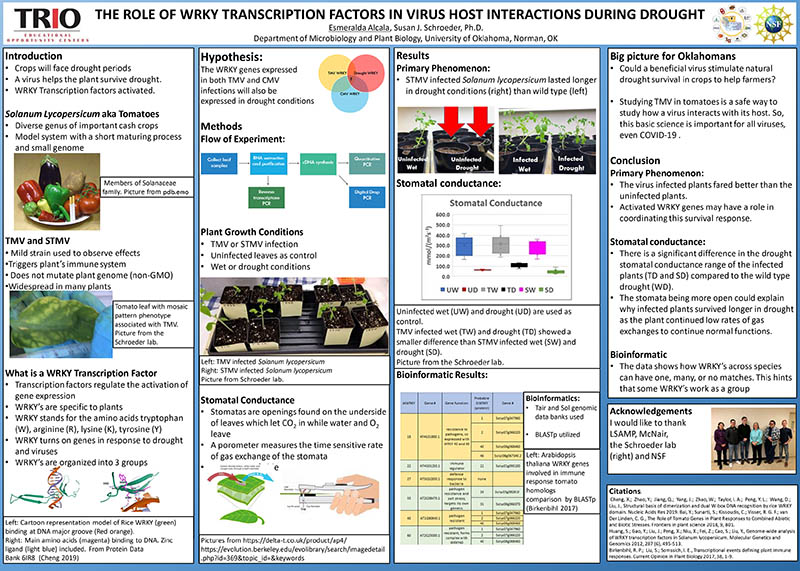
Hover to pan and click to magnify. Click again to pan at full screen.
Esmeralda Alcala, S. Schroeder, J. Macias, W. Runion and D. Pfaff, Dept. of Microbiology and Plant Biology, University of Oklahoma, Norman, OK. Faculty Advisor, Dr. Susan Schroeder, University of Oklahoma, Norman, OK.
Esmeralda Alcala, S. Schroeder, J. Macias, W. Runion and D. Pfaff, Dept. of Microbiology and Plant Biology, University of Oklahoma, Norman, OK. Faculty Advisor, Dr. Susan Schroeder, University of Oklahoma, Norman, OK.
ABSTRACT
The change in climate across the world has been a concern for the agricultural industry especially when it comes to drought. The common response so far has been to genetically modify the plants (GMOs) but there are many concerns with this practice. An alternative method is to stimulate the plant’s immune system by infecting it with a specific plant virus which will handle drought stress better than an uninfected plant. To test this method, we analyze the gene expression of plants dealing with drought conditions through a group of transcription factors unique to plants called WRKY (named after the main amino acids in the sequence). In this study, the WRKY genes of interest are from the tomato plant, Solanum lycopersicum. The WRKY genes of interest are from the Solanum lycopersicum tomato plant, which we infected with Tobacco Mosaic Virus (TMV) or Satellite Tobacco Mosaic Virus (STMV). The methods used are stomatal conductance, RNA extraction and purification, reverse transcriptase PCR, gel electrophoresis, cDNA synthesis, quantitative PCR, and bioinformatics. Results from the stomatal conductance shows how the infected plants had a greater range compared to the uninfected. For the bioinformatic, I used Tair and Sol genomics data banks to compare similar genes, also called homologs, across species. I found the genes were involved in either pathogen or drought stress and were mainly in group three. Tracking the common WRKYs expressed after a plant is infected helps us understand the specific WRKYs activated for each virus. We hypothesize that the commonly expressed WRKY factors in different virus infections might also be responsible for drought tolerance.

DISQUS COMMENTS WILL BE SHOWN ONLY WHEN YOUR SITE IS ONLINE